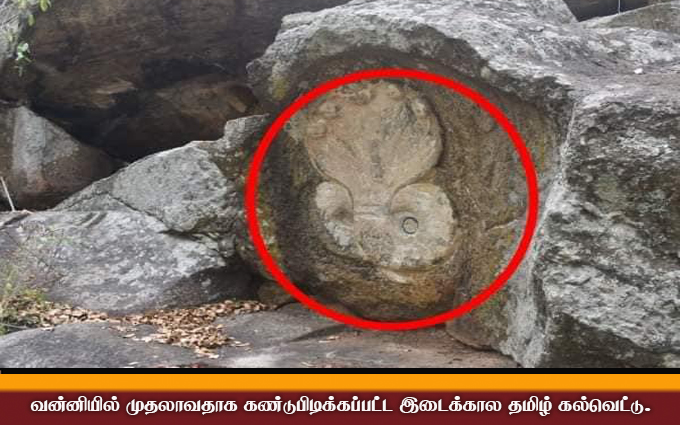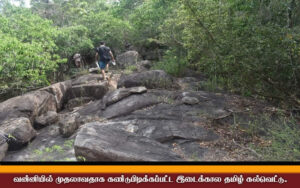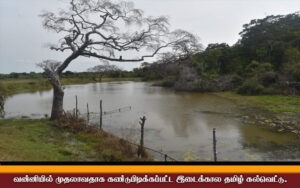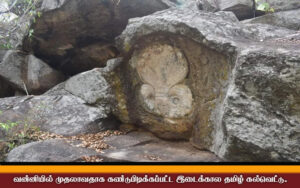

The uncovering of this inscription represents a significant milestone

The uncovering of this inscription represents a significant milestone as the first medieval Tamil artifact identified within the Vanni, opening a new chapter in understanding the region’s indigenous Tamil heritage.
Under the guidance of Prof. P. Pushparatnam, a group comprising archeology educators, students, and survey officials; Mr. Kapilan and Mr. Manimaran from the Department of Archeology embarks on a significant archaeological mission in Vanni, aiming to delve into the area’s historical layers.
During ongoing archaeological research, a Tamil inscription from the 12th-13th century AD has been uncovered near the abandoned pond in Vanni known as Periapuliangulam.

Initially repurposed and relocated from its original location by the area’s residents as a pedestal for idols within the Vairavar temple, the stone’s historical importance was later identified by Mr. Jayadeepan of the Vavuniya Pradeshiya Sabha, Tamil Eelam.
After he communicated this to Mr. Manimaran, experts from the Jaffna University archaeology department undertook a detailed analysis of the stone’s inscriptions. The fragmented lower section of the inscription, which contains several lines of text, were now accessible for examination. The artifact features five lines of text, with the first line displaying a high degree of mutilation among its letters. The names or messages within those lines are obscured due to the mutilation, but the other four lines remain legible.
The text of the Tamil inscription has been deciphered by scholar Professor Subparayalu as follows.
Anjai three days
(Nma) Anjai Valla-
Maryan Sathyam e-
The Destroyer will enter Hell.
 Those who ignore a temple donation or a ruling by a government or any institution are bound to be ruined and suffer in hell. The intent of this epitaph is to broadcast this message unequivocally.
Those who ignore a temple donation or a ruling by a government or any institution are bound to be ruined and suffer in hell. The intent of this epitaph is to broadcast this message unequivocally.
In his interpretation of the Tamil inscription, Professor Subparayalu postulates that ‘Moonru Tha (Nma)’ could allude to either the Tamil mercantile forces in Vanni during the 12th-13th century AD or the Tamil army formations called Velakarkar, Itangai, and Valangai, highlighting the military organization of that era.
The name Vallavarayan might refer to a ruler in Vanni or to the deity Vinayaka (Ganapati). It’s worth noting that in inscriptions from 11th-12th century AD Tamil Nadu, Vallavarayan is often used to refer to Lord Vinayaka (Ganapati), confirmation of this interpretation awaits the discovery of the remaining parts of the inscription. From the studies carried out so far, it has been revealed that this inscription was taken from the ruins of a building in the forest there.

Therefore, it can be anticipated that most inscriptions are situated within those architectural remnants. And as research progresses, it is probable that the rest of the inscription and additional inscriptions will be discovered there. Given that this is the first medieval Tamil inscription found in the Vanni region, its importance in Vanni studies is beyond question.
Nedunkeni Sanujan